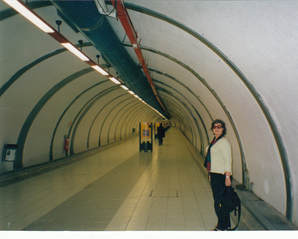 Sherrill, Rome Metro, Via Veneto
Sherrill, Rome Metro, Via Veneto * * *
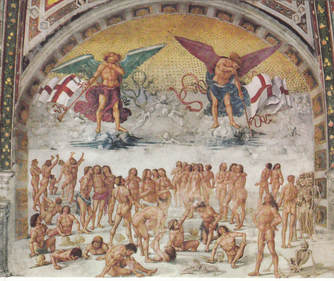 Signorelli's fresco, "Resurrection," Orvieto
Signorelli's fresco, "Resurrection," Orvieto Once again, we were traveling with a list of places to stay but no reservations. Every day was an adventure. We were lucky this time. After riding in Orvieto's funicular to the top of the cliff, we walked to a hotel across the central piazza and were given a room with a view of the cathedral's ornate front with its stained glass, sculptures, and mosaics—although half of that elaborate facade was covered with scaffolding. Inside, we discovered three enormous frescoes overflowing with naked bodies: Luca Signorelli's paintings of The Damned, The Resurrection, and Paradise.
"I think the subject was an excuse for him to show off," Sherrill commented.
* * *
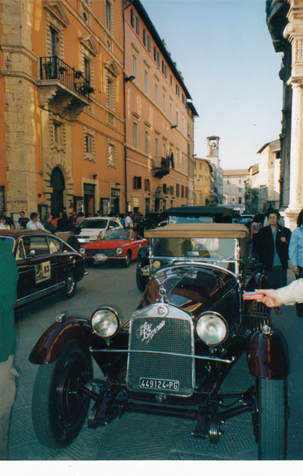 Antique car rally, Perugia
Antique car rally, Perugia We ate well in Italy's hill towns, sometimes hunting up a restaurant that had been recommended to us, but usually just stopping at one that looked good. The dishes were interesting, the ingredients fresh, and the wine usually local and excellent—and it was fun eating with local people. As we strolled through Perugia's medieval streets, through stone arches and narrow passageways decorated with carved coats of arms, along a Roman aqueduct for a while, passing the old buildings of the University, and stopping to visit the National Gallery to study masterpieces by Perugino, Piero della Francesco, and Pinturicchio, we discovered some enticing neighborhood restaurants and weren't disappointed. Often, in these little places the chef himself (back then, they usually were male) came out to talk about the menu with us, urging us to try a dish with the local truffles or their special way of preparing lamb with olives—and, of course, there always was a local wine that we couldn't miss. In fact, the only times in all of our travels through Italy that we were disappointed by a restaurant were when we stumbled into places targeting tourists, which did happen a couple of times in Venice and Naples.
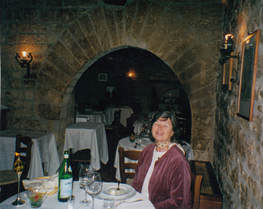 Sherrill, Gubbio restaurant
Sherrill, Gubbio restaurant Gubbio rose on one side of a valley, its cobblestone streets a series of horizontal steps climbing up the mountain like a ladder, pocked occasionally by piazzas, churches, a few Roman ruins, and several medieval public buildings—the crenellated Palazzo dei Consoli (city hall), the ducal palace—and our favorite, the Palazzo del Bargello for the Society of Crossbowmen. Every December, the biggest Christmas tree in the world was created here with 12 kilometers of electric lights that stretched from the bottom of the city to the top of the mountain. We were there in May, but at sunset the ancient stones and tile roofs of Gubbio blazed as if washed with liquid gold.
"A wedding," Sherrill told me, "and papa has to take his turn with the kid."
Sure enough, before long the big wood doors opened wide, spilling a crowd of well-dressed people, a priest, members of a youthful chorus, and finally the wedding party, bride and groom last of all: a petite, lovely girl in white and a husky dark-haired young man who looked uncomfortable in his suit. Several more restless children scurried around the adults and darted into the piazza.
"Our lucky day," Sherrill said, and I agreed.
Traveling can be a disorienting experience, simultaneously being here and there, in the present and the past, as if we've been in submerged in a great stew, bits and pieces of time bubbling around us. Later, that stew only partially congeals, tricking our memories: the Roman theatre, the gothic church, the Victorian farm house, the Romanesque cathedral, the bride lifting her skirt as she maneuvers over cobblestones, the hotel room with sagging floor: which was where and when?
* * *
We were sweating already and had just started hiking up the winding road from the Assisi train station to the town center someplace on the mountainside in front of us. Since Assisi hotels booked up far in advance, we had a reservation at a small hotel near the central piazza, supposedly walking distance to everything—except the train station, we now realized. Our two suitcases were carryon, but heavier than we'd thought. Stoically, we trudged forward.
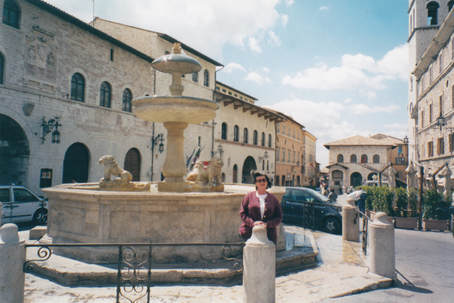 Sherrill, Piazza del Comune, Assisi
Sherrill, Piazza del Comune, Assisi The driver's door opened with a flourish and a tiny nun emerged. She walked around the hood until she was face to face with us.
"Where are you going?" she demanded, in accented but understandable English.
"Piazza del Comune," I answered. "Hotel Umbra."
The nun, older than I'd realized at first, swung open the passenger door.
"Get in," she commanded, reaching for our suitcases. Before we could react, she'd opened a miniscule trunk, somehow got the two bags into it, and slammed it shut. "In!" she repeated.
We obeyed.
The nun forced the little vehicle into motion, whipping around every bend in the road, detouring violently around any object—car, human, animal, or structure—that rose up in front of us. Crammed into the car next to the nun, no seatbelts, hoping the door wouldn't fly open and we wouldn't crash through the windshield, somehow we survived our first experience of Assisi, emerging at last in a large piazza, where our nun slammed to an abrupt stop.
"Hotel?" she barked.
"Hotel Umbra."
We didn't see anything that looked like a hotel.
She tumbled out of the car and trotted over to a uniformed poliziotto parked a few yards away. A moment later, they walked back to us, talking and gesturing. Struggling out of the car, Sherrill and I looked hopefully at the young cop.
"Hotel?" the nun asked again.
"Hotel Umbra."
"Ahh!" said the poliziotto after a minute, then pointed down what looked like a cross between a tunnel and an alley.
"Bravo!" cried the nun, triumphantly, hurling our bags onto the cobblestones. "Buona fortuna!"
"Grazia!" I cried, as she slid back into the car, gunned it, and drove off.
"What just happened?" Sherrill asked.
"Our fairy godmother was an Italian nun."
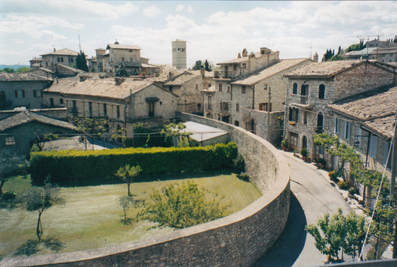 Assisi: round street on site of Roman theatre
Assisi: round street on site of Roman theatre The next days spun into a kaleidoscope of wonders, from the Roman Temple of Minerva practically next door on the Piazza del Comune to the monumental multi-level complex honoring St. Francis of Assisi astride the hill above. Both the upper and lower churches had been restored since the 1997 earthquake and the great frescoes by Cimabue and Giotto and his followers restored as much as possible. From the lower church we descended to the crypt to pay our respects at the tomb of the saint. Despite the hills, we enjoyed exploring the medieval city: the narrow streets lined with stone houses, the arches joining buildings over the streets, the reddish roof tiles, decorated cornices, even the occasional bricked up door and window, sometimes still blackened from a long ago sacking. From time to time, the medieval austerity of the neighborhoods was lightened by window boxes and baskets of geraniums. Climbing farther afield, we came to a delightfully odd neighborhood of medieval houses built within the circular framework of what had been a Roman theatre.
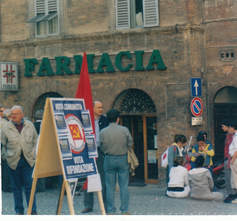 Communists campaigning, Urbino
Communists campaigning, Urbino "He sing alla radio tonight. You must hear him. Magnifico!"
We didn't hear the chef's son sing, but the food was pretty magnificent—and so was the bottle of ruby red Rosso Piceno Superiore. Somehow, after that feast, we made it back to our hotel—although I seem to recall that one or two university students helped us get there.
* * *
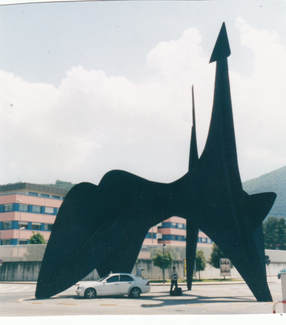 Alexander Calder statue, Spoleto
Alexander Calder statue, Spoleto 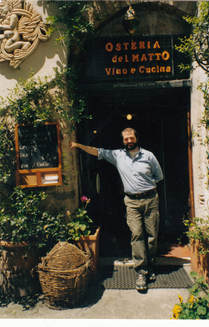 Spoleto restaurant, host/owner
Spoleto restaurant, host/owner A couple of days later, we checked out of our hotel and went to catch the local bus to the train and bus station. When it didn't show up, we returned to the hotel and learned that it didn't operate on Sunday. A brisk walk with our bags got us to the station just in time for the bus to San Marino, proudly the world's oldest republic and Europe's third smallest independent state—although completely surrounded by Italy.
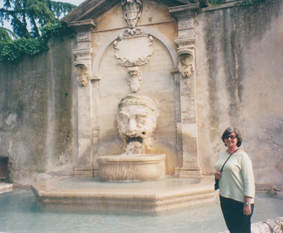
If you find these posts interesting, why not explore the rest of my website, too? Just click on the buttons at the top of the page and discover where they take you—including a bio, information about my four novels, along with excerpts from them, and several complete short stories.
Please pass the posts on to anybody else you think might enjoy them.
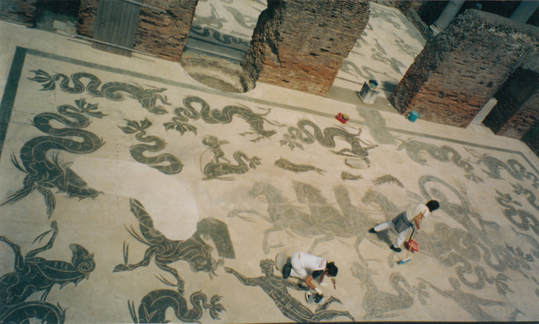
 RSS Feed
RSS Feed